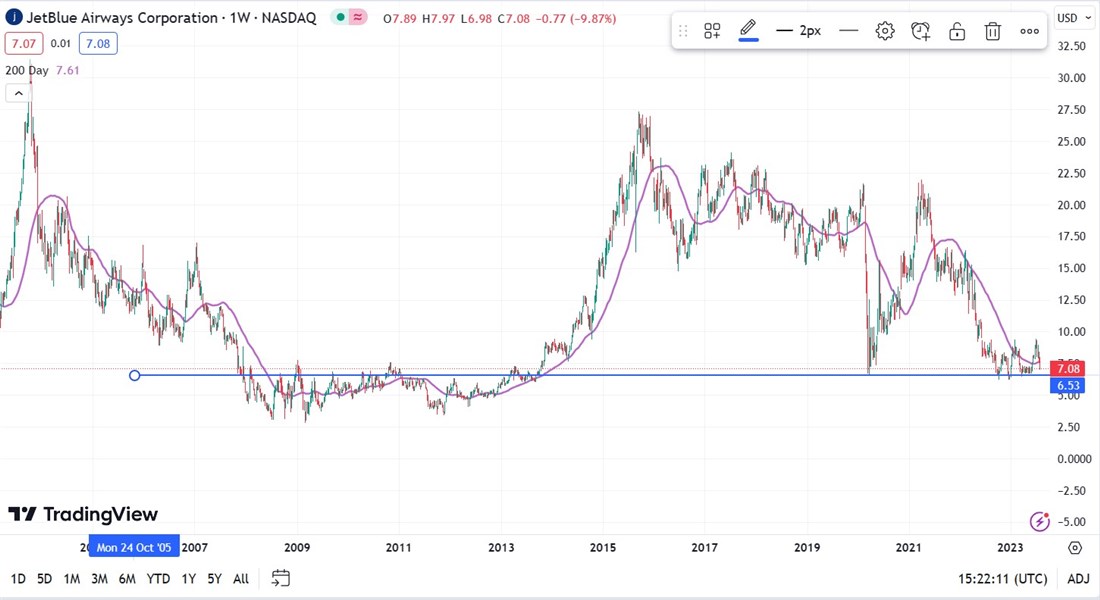 Shares of JetBlue Airlines (NASDAQ: JBLU) are declining by as much as 8.5% during Tuesday's trading session; the significant move down is coming from the company's release of its second quarter 2023 earnings results. Markets may be overreacting by selling highly cyclical stocks, like JetBlue, as the United States manufacturing PMI index was reported below expectations this morning.
Shares of JetBlue Airlines (NASDAQ: JBLU) are declining by as much as 8.5% during Tuesday's trading session; the significant move down is coming from the company's release of its second quarter 2023 earnings results. Markets may be overreacting by selling highly cyclical stocks, like JetBlue, as the United States manufacturing PMI index was reported below expectations this morning.
Understanding that the reaction to the stock is an overextension relative to what happened regarding the company's financials, as well as a relative valuation within the sector benefitting investors today, can begin to paint a picture of JetBlue being a value play in the making. JetBlue analyst ratings point to a potential double-digit upside from today's prices. This opinion is backed by factors that will become clear shortly.
Now that JetBlue's stock chart is showing signs of a potential pivot, backed by a new surprising management strategy, investors may be in for a treat. Being able to gain exposure in a turnaround story, which also happens to be the cheapest alternative in the airline sector, can be the right pocket to look into for outsized returns in a potential purchase.
Management's New Strategy
After other domestic airlines like Southwest Airlines (NYSE: LUV) reported a drying up of domestic travel NYSE: LUV" target="_blank" rel="noopener">volumes, alongside expected rises in underlying fueling and maintenance costs, JetBlue management has decided to jump the gun and pivot into a more diversified model. Despite lowering guidance and showcasing some contracting financials, investors have to give management a break for recognizing what needs to be done and acting toward its achievement.
Within the company's earnings release, JetBlue's management stated the intention of redeploying capacity in the coming months. The company began its daily service network to and from New York and Paris, expanding its transatlantic service options with further plans to develop into a Boston to and from Paris in 2024.
Furthermore, JetBlue has expanded its routes to the Caribbean via new service availability to Puerto Rico and other islands such as Belize and St. Kitts. Steering away from the concentration of U.S.-only domestic travel, the company will not only accrue to its top-line net sales figures but also diversify the cyclical risk that comes with relying on one single market.
Understanding that today's decline in JetBlue's stock may be coming from a tendency to judge the name based on its past and current business model rather than weighing the potential benefits of management's future pivot can lead contrarian investors into the promised land.
Only a few market participants are considering the pending merger with Spirit Airlines (NYSE: SAVE), which regulators may expedite and approve now that JetBlue's Northeast Alliance with American Airlines (NASDAQ: AAL) has been. The revenue expansion coming from this mix and cost savings are being underrated by markets today.
Speaking of costs, management made sure to highlight to investors their recent achievements in their cost-saving program. The company delivered over $75 million in cost reductions from their fleet modernization initiatives as the airline transitions into the Airbus A220 model. And referring to the fleet on hand is more efficient than ever and more considerable as the company grew capacity by 5.8% during the past twelve months.
The Perfect Storm
Net revenues grew by 6.7% over the year for JetBlue, nothing to punch the 'Buy' button at. However, investors can begin to wake up to reality when this growth rate is taken along with the 12.2% reported contraction in operating expenses. As margins expand and are expected to grow as the fleet is modernized and the benefits of a merger hover over the company's future, profitability and EPS growth are set to kick in soon.

Looking at the above chart, investors can see that the thick blue line, which has acted as a heavily traded support and accumulation level, is close to being tested after today's extraordinary decline. More importantly than this double - even triple - the bottom is the infamous 200-day moving average represented by the thick purple line across the price candles.
Now that the stock has crossed above the moving average, typically taken as a proxy for bull and bear markets, investors are beginning to get a taste of potential future momentum. Traveling above the moving average is one thing; however, seeing that the moving average has turned upward further confirms a pivot in the previous downtrend, opening the way for a potential new rally.





